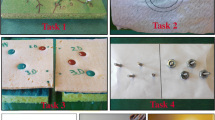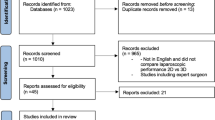Abstract
Introduction
Studies have shown that using robotic-assisted laparoscopy (RL) increases performance compared to conventional laparoscopy (CL) due to its mechanical advantages but have not assessed distraction as a factor. To determine whether the immersive aspect of the 3D optics in RL contributes to improved performance, we compared the outcomes of laparoscopic skills by using just the 3D optics of the da Vinci versus the conventional 2D monitor with and without distraction.
Methods
Thirty-two participants without any laparoscopic experience were randomized evenly into four groups: RL, robotic-assisted laparoscopy with distraction (RL + D), CL, and conventional laparoscopy with distraction (CL + D). Each participant performed three Fundamentals of Laparoscopy Surgery tasks [peg transfer (Task 1), circle cutting (Task 2), and suturing with knot (Task 3)] for three repetitions. For each task, the mean time and errors were recorded and analyzed statistically for each group.
Results
Compared to other groups, CL + D took on average 1 min longer to complete Task 1 (P = 0.001), more than 1 min to complete Task 2 (P = 0.003), and more than 2 min to complete the Task 3 (P < 0.001). On Task 2, the deviations from the pattern were shorter for RL and RL + D compared to CL and CL + D (mean 0.33 and 0.37 cm vs. 0.55 and 0.58 cm, respectively; P < 0.001). On Task 3, the deviations were also shorter for RL and RL + D compared to CL and CL + D (mean 0.23 and 0.24 mm vs. 0.61 and 0.63 mm, respectively; P < 0.001).
Conclusion
When distraction was introduced, CL performed significantly worse. This suggests that using the conventional 2D monitor does not help with blocking out distraction. For Tasks 2 and 3, which require more precision and depth perception, the groups that used the 3D optics had shorter mean deviations than groups that used the conventional 2D monitor. This suggests that even when the robotic arms of the da Vinci are removed, there are still advantages to the immersive 3D optics, especially when distraction is present. The immersive aspect of the 3D optics may help improve performance in the OR, allowing surgeons to be more focused on the case and have greater depth acuity.




Similar content being viewed by others
References
Subramonian K, Desylva S, Bishai P, Thompson P, Muir G (2004) Acquiring surgical skills: a comparative study of open versus laparoscopic surgery. Eur J Urol 45:346–351
Kim HJ, Choi GS, Park JS, Park SY (2014) Comparison of surgical skills in laparoscopic and robotic tasks between experienced surgeons and novices in laparoscopic surgery: an experimental study. Ann Coloproctol 30(2):71–74
Sarle R, Tweari A, Shirvastava A et al (2004) Surgical robotics and laparoscopic training drills. J Endourol 18:63–66
Anderberg M, Larsson J, Kockum CC, Arnbjörnsson E (2010) Robotics versus laparoscopy—an experimental study of the transfer effect in maiden users. Ann Surg Innov Res 4:3
Hassan SO, Dudhia J, Syed LH, Patel K, Farshidpour M, Cunningham SC, Kowdley GC (2015) Conventional laparoscopic vs robotic training: which is better for naïve users? A randomized prospective crossover study. J Surg Educ 72(4):592–599
Heemskerk J, van Gemert WG, de Vries J, Greve J, Bouvy ND (2007) Learning curves of robotic-assisted laparoscopic surgery compared with conventional laparoscopic surgery: an experimental study evaluating skill acquisition of robot-assisted laparoscopic tasks compared with conventional laparoscopic tasks in inexperienced users. Surg Laparosco Endosc Percutan Tech 17:171–174
Wheelock A, Suliman A, Wharton R, Babu ED, Hull L, Vincent C, Sevdalis N, Arora S (2015) The impact of operating room distractions, workload, and teamwork. Ann Surg 261(6):1079–1084
Guru KA, Kuvshinoff BW, Pavlov-Shapiro S et al (2007) Impact of robotics and laparoscopy on surgical skills: a comparative study. J Am Coll Surg 204:96–101
Yohannes P, Rotariu P, Pinto P, Smith AD, Lee BR (2002) Comparison of robotic versus laparoscopic skills: Is there a difference in the learning curve? Urology 16:1790–1792
Bhayani SB, Andriole GL (2005) Three-dimensional (3D) vision: Does it improve laparoscopic skills? An assessment of a 3D head-mounted visualization system. Rev Urol 7:211–214
Tanagho YS, Andriole GL, Paradis AG, Madison KM, Sandhu GS (2012) 2D versus 3D visualization: impact on laparoscopy proficiency using the fundamentals of laparoscopic surgery skill set. J Laparoendosc Adv Surg Tech 22:9
Chan AC, Chung SC, Yim AP et al (1997) Comparison of two-dimensional vs three-dimensional camera systems in laparoscopic surgery. Surg Endosc 11:438–440
Jones DB, Brewer JD, Soper NJ (1996) The influence of three-dimensional video systems on laparoscopic task performance. Surg Laparosc Endosc 6:191–197
Funding
Funding for this study was obtained from University of Nevada, Reno. We received an equipment grant from Intuitive Surgical.
Author information
Authors and Affiliations
Corresponding author
Ethics declarations
Disclosures
Shawn Tsuda receives honoraria and is a proctor for Intuitive and speaker/trainer for Acelity. Steven Kim, Audriene May, Heidi Ryan, Adnan Mohsin, and Shawn Tsuda have nothing to disclose.
Rights and permissions
About this article
Cite this article
Kim, S., May, A., Ryan, H. et al. Distraction and proficiency in laparoscopy: 2D versus robotic console 3D immersion. Surg Endosc 31, 4625–4630 (2017). https://doi.org/10.1007/s00464-017-5525-x
Received:
Accepted:
Published:
Issue Date:
DOI: https://doi.org/10.1007/s00464-017-5525-x




